Getting Sentimental: Using Emotional Signals in eDiscovery
Our written communications can be heavily larded with “sentiment”. In common parlance, sentiment is “the emotional significance of a passage or expression as distinguished from its verbal context“. At Reveal, we characterize sentiment as the tone of the language used in a communication such an email message.
As litigators, investigators, and the people who support them, if we can find and analyze sentiment in discovery documents then we greatly improve our ability to figure out who did what, when, where, how, and most notably why.
Content conveying sentiment can be especially useful in providing context. It can help us better understand the emotional circumstances leading to the formulation of an idea, the framing of a statement, the initiation of an action. It can provide insights into what motivated people to act as they did.
At Reveal we think of sentiment not just what as people say but how they say it. Our tools to assess sentiment look not only at numbers and statistics but also at the emotional content of the language they use. With these tools, we deliver a platform that has its own “emotional intelligence” and that can augment yours. In today’s post, we explore ways Reveal’s platform increases your ability to find sentiment in your ESI and to analyze that sentiment.
Searching for Sentiment is Your Data
Reveal AI uses unsupervised machine learning to look for language expressing sentiment. As we discussed in Legal AI Software: Taking Document Review to the Next Level and What Is An AI Model?, unsupervised machine learning is, essentially, an exercise in having computers “tell me something I don’t know.” Computer algorithms are pointed at data. The algorithms organize that data based on patterns, similarities, and differences. The algorithms work on their own; they do not rely on people to train them. They can, however, learn from their own experience.
Reveal AI looks for seven types of sentiments:
• Intent: Looking at someone’s intention or purpose. “I will do this.”
• Opportunity: Looking for circumstances making it possible for someone to do something. “I can do this.”
• Pressure: Looking for attempts to persuade, influence, intimidate. “You must do this.”
• Rationalization: Looking for attempts to explain or justify. “It’s okay to this because….”
• Sentiment Alternation: Looking for fluctuations in how people speak, detecting discomfort and tone changes, mainly to detect dishonesty.
• Positivity: Looking for content that tends to the positive and optimistic. ![]()
• Negativity: Looking for content where people discuss negative things, which can lead to discovering conversations about problems. ![]()
When Reveal AI encounters content containing any of these sentiments, its assigns a score to that content. Scores start at 1 and go up from there. How far up the scores go is a function of the content evaluated and the sentiments expressed. For more convenient searching, scores also are organized into groups. When searching for content containing emotions, you can choose from the following options:
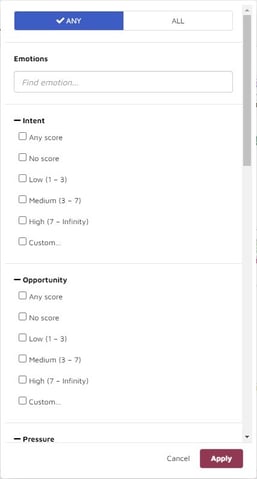
• Any score
• No score
• Low (1 – 3)
• Medium (3 – 7)
• High (7 – Infinity)
• Custom
You can search for any combination of the first four groups (Intent, Opportunity, Pressure, and Rationalization) along with either Negative or Positivity.
When searching for emotional signals in your content, it often helps to start with people first and go to sentiment second. Assume, for example, that you are working on a theft of intellectual property matter where a company’s salesperson and a manager from a key competitor allegedly stole company customer lists. You might want to look for conversations that bring their planning efforts to light. To explore that, you could look for
• Communications between the salesperson and the manager,
• Where the communications took place after business hours, and
• Where the salesperson and manager used multiple email addresses (work, personal, cryptic), and/or
• The salesperson and the manager used more than one means of communication (email, text, voice message), and
• The communications had high Intent scores as well as medium or high Pressure scores.
The search could look like this, if were to assume for this exercise that Vince Kaminski was the salesperson and Shirley Crenshaw was the manager:
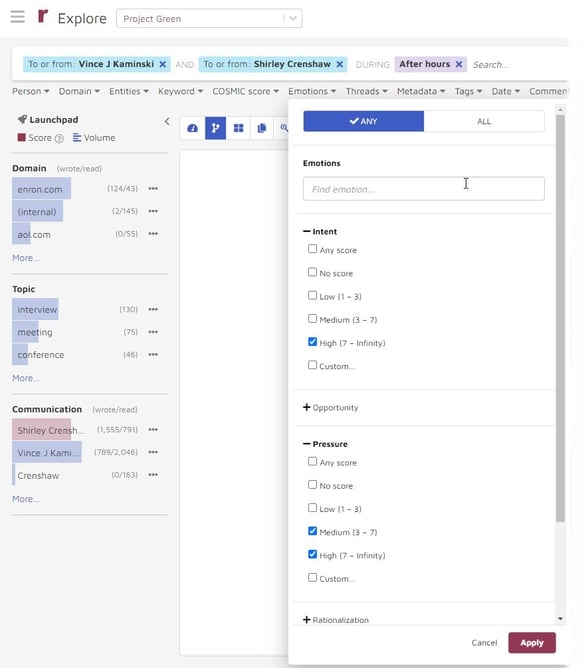
The results look like this. The search returned six communications threads directly between Kaminski and Crenshaw where the communications took place after regular business hours or on weekends and contained content with high Intent and medium or high Pressure scores. It also returned additional indirect communications which you might decide to explore.
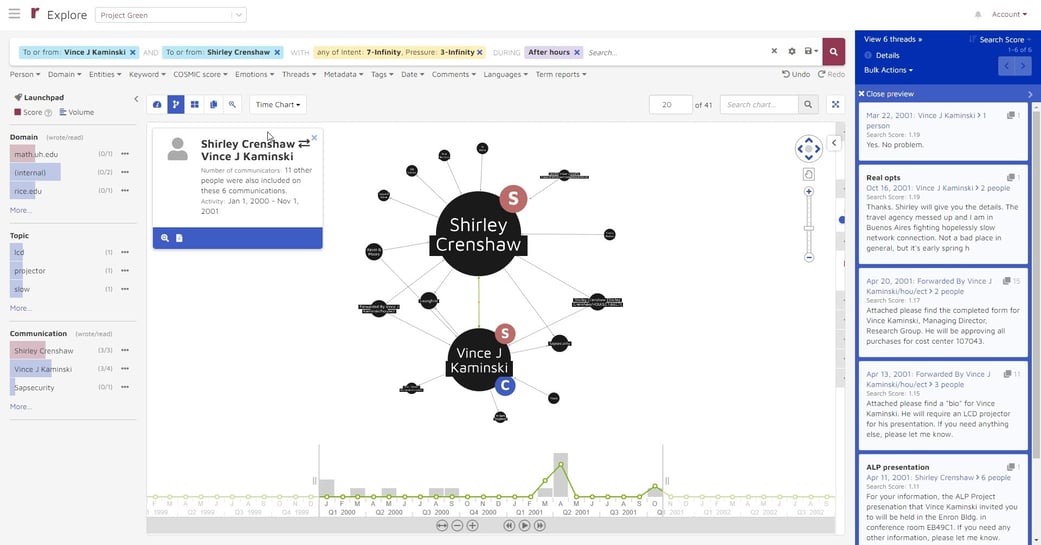
Positivity and Negativity are handled differently from the other sentiments. Positivity and Negativity are part of a single continuum. As a result, you can search either for documents with Positivity scores or for documents with Negativity scores, but you cannot search for documents with both Positivity scores and Negativity scores.
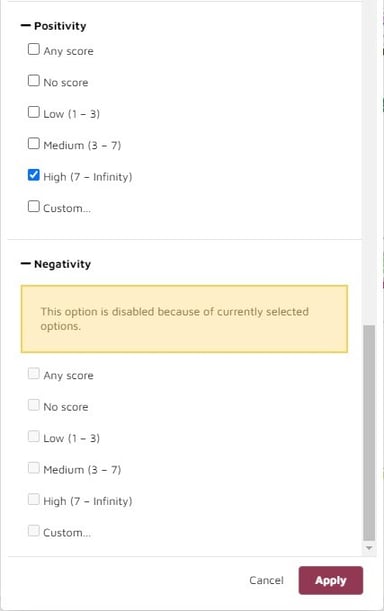
Working with Sentiment
Reveal AI offers various ways to work with the results of searches for sentiment. They include Connection Maps, Baseball Cards, and Cards, which we will examine in this post, as well as in a number of other ways.
Here is an example of the results you can get if you look for sentiment.
Step One – Initial View: Here is what you might see if you were to look at the Enron data, before you begin searching the data. For this example, we are looking at the data in Reveal AI, using the communications and time chart view. You can see a visual summary of communications between individuals. It summaries 225,562 threads.
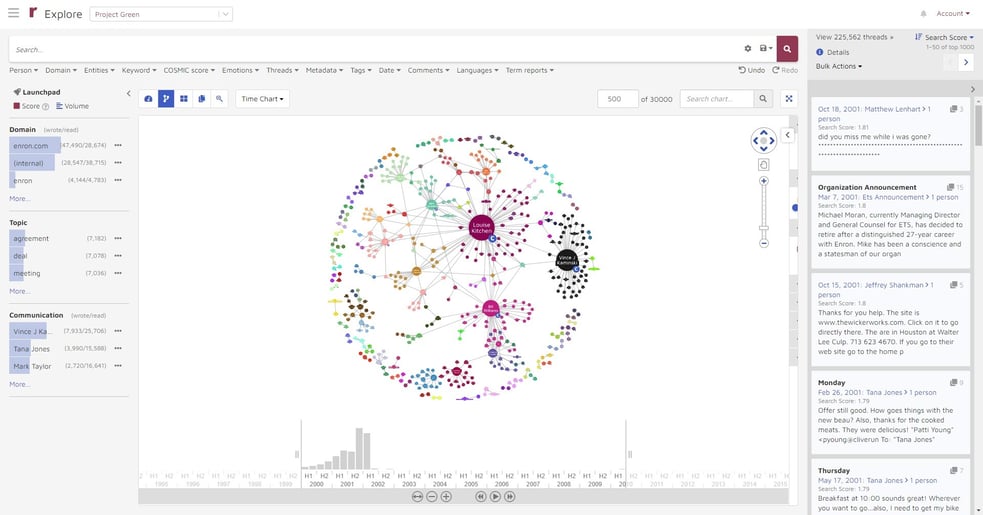
Step Two – High Negativity: Next, I searched for documents where Negativity is high. The resulting set of documents is much smaller, 3,690 threads. There communications map looks different, and you can see a different timeline as well.
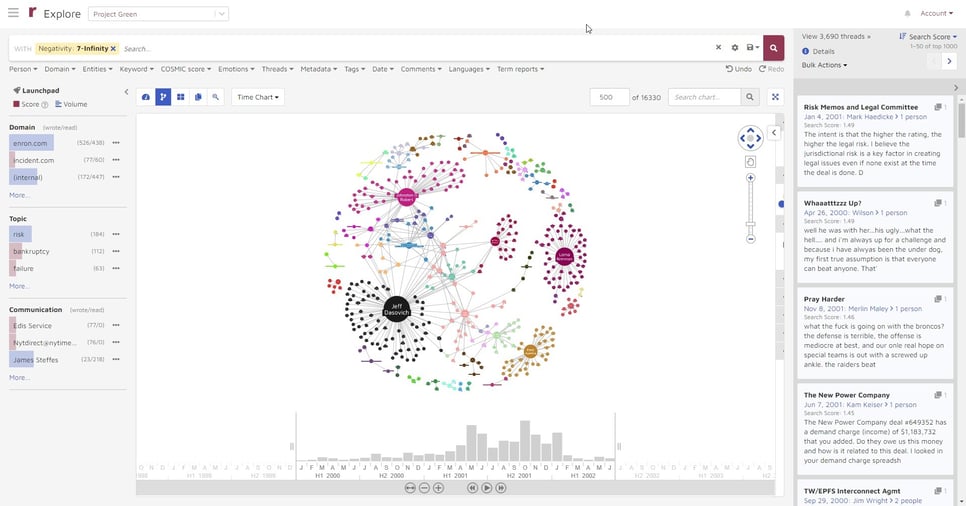
Step Three – High Negativity and Person: To demonstrate a combined search, I added to my search, looking for documents where Negativity is high AND where they are to or from Vince Kaminski. The search result set is much smaller, just 219 threads, and you can see the differences on the screen.
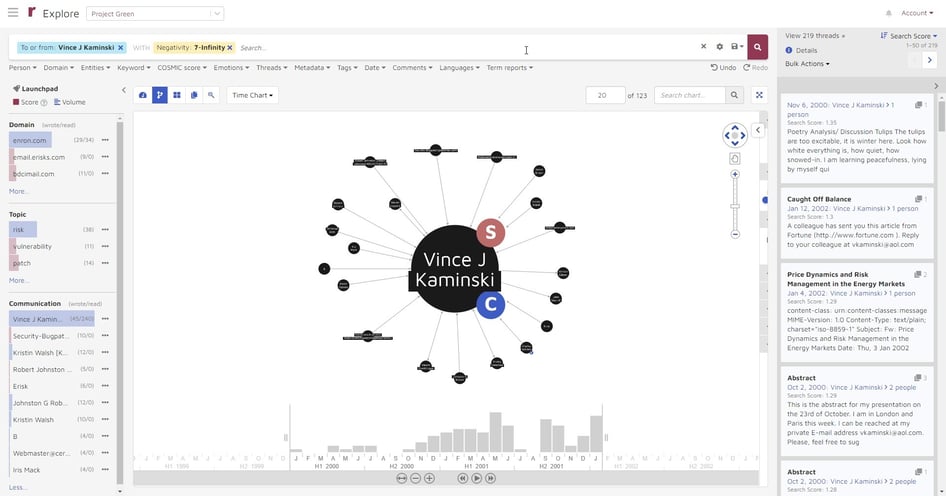
Connection Map
As its name suggests, Reveal AI’s Connection Map (the display shown above) lets you see a map of communications between people. It shows a person’s name, the people with whom that person communicates, and how many times they communicate.
The Connection Map has many components, including navigational controls, groupings, network analysis, link labels, and more. It also contains a Settings Panel where you can select emotional models to overlay on the map, filtering using High, Medium, and Low cutoff thresholds.
In the example below, I searched for communications that discussed “Jeff Dasovich” and that contained emotional content with High or Medium Negativity.
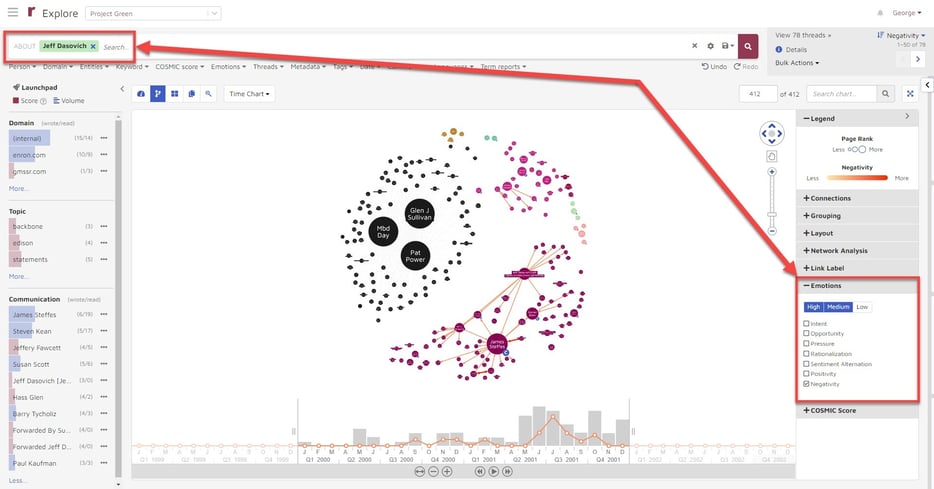
Zooming in, we see connection lines of varying thicknesses and colors. These indicate how strongly the communications fit the selected emotion.
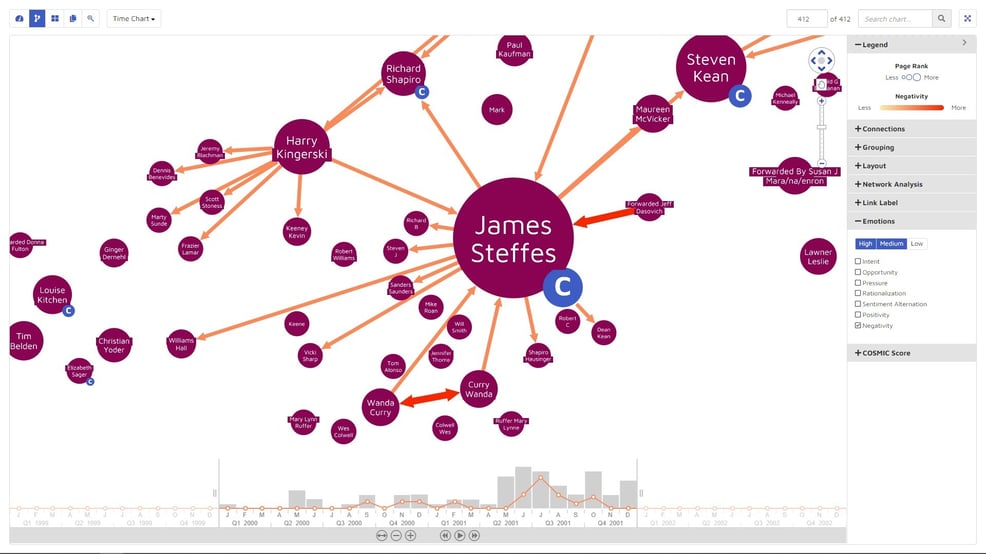
Using the timeline, displayed at the bottom of the window, you can see how these connections play out over time.
Baseball Cards
Reveal’s Baseball Cards show profiles of entities, as we discussed in What is an Anomaly?
They also display emotional content. Each baseball card shows hotly debated topics of interest from the selected person's documents. These are the top seven topics whose content exhibits medium or high negative sentiment, sorted by sentiment score in negative order.
Each baseball card also shows tenuous communications. These are the top four people with when this person had communications whose content indicate medium or high negative sentiment.
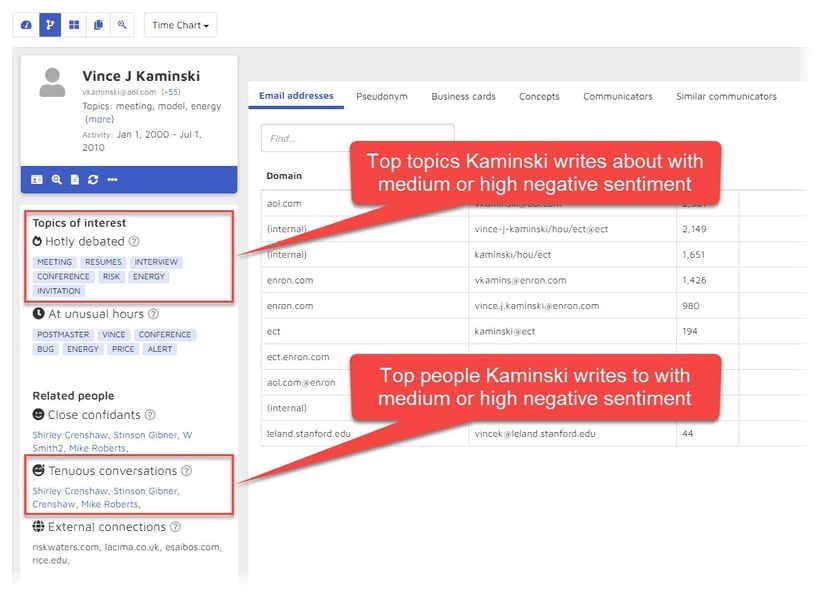
Cards
Reveal’s Cards offer yet another way to work with sentiment. In this example, I searched for communications that discussed “Vince J Kaminski” and that contained emotional content with High or Medium Pressure. You can see, highlighted, one card with Negative sentiment and another with Positive sentiment.
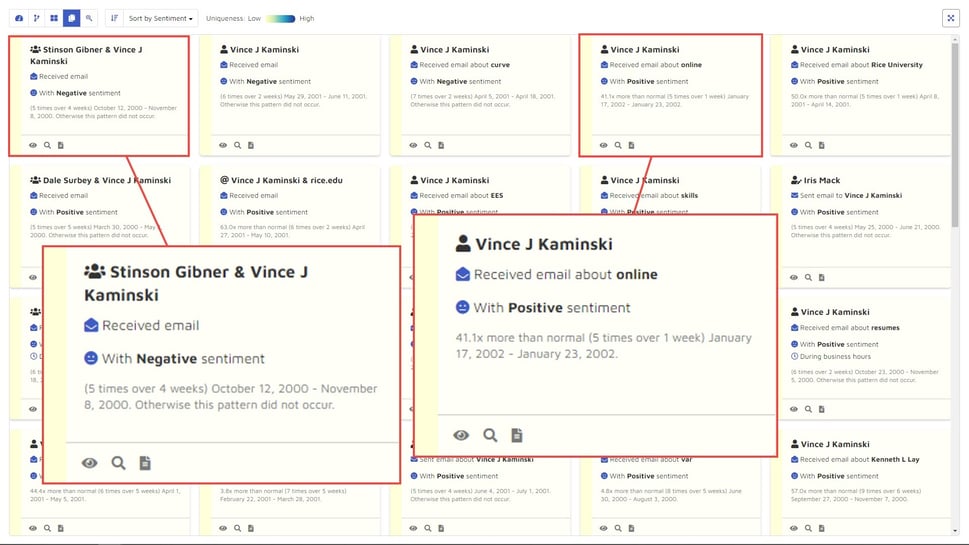
Go Forth & Explore
As you can see, the ability to search for content expressing sentiment opens opportunities to investigate your data in ways traditional approaches to search cannot match. If your organization is interested in learning more about sentiment analysis and how Reveal uses AI as an integral part of its AI-powered end-to-end legal document review platform, contact us to learn more.

